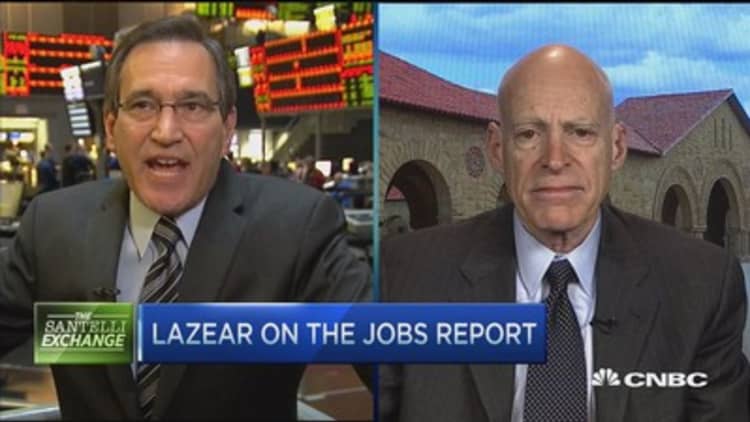
May's strong 280,000 employment gain reaffirmed market expectations that September may be the month when the Fed raises interest rates for the first time in nine years.
If the solid jobs report is confirmed by other economic data, it suggests that the second quarter may not be quite as sluggish as some fear, and the Fed, therefore, may be more willing to move to end the era of zero interest rates.
Read MoreJob growth shows late spring heat wave
"It re-establishes momentum and keeps them on track for a September rate hike. That's the bottom line," said Deutsche Bank's chief U.S. economist, Joseph LaVorgna. He had expected 275,000 nonfarm payrolls while Wall Street's consensus was for just 225,000 jobs.
The report also showed a slightly better-than-expected 0.3 percent increase in average hourly wages in May, taken by some traders as an early sign that wage growth and inflation may finally be picking up—a necessary ingredient for rate hikes.
After a week of wild swings, bond yields immediately ripped higher with the 10-year again reaching the 2.42 percent level, revisiting the eight-month high hit for the first time Thursday. The two-year note yield was at the highest level of the year, at around 0.74 percent. The two-year is the part of the curve most reflective of rate increase expectations.
The dollar index gained, rising 1.3 percent on the day to 96.66. Stocks initially sold off but moved higher as financial shares gained on the expectations that higher interest rates would boost their earnings. Utilities, a popular dividend play for a low-yield environment, fell by 1 percent.
Wall Street is divided on when the Fed will move, with a group expecting September, another December and some do not believe the central bank will hike until next year. This week, two Fed governors warned about economic weakness, raising speculation the Fed could hold off until later in the year or next year.
Mesirow Financial's chief economist, Diane Swonk, said she had been on the fence before Friday's jobs report and was thinking of changing her forecast for a rate hike to December from September because of economic weakness.
"This restarts the clock on September," said Swonk. The jobs report also included positive revisions to March and April, adding 32,000 jobs.
"It's good in so many ways. It shows signs of healing," said Swonk. "The composition of gains was very beneficial to new grads, and leisure was higher. We actually had a snap back on hospitality that confirms consumers are spending. ... It affirms some of it was transitory and affirms consumers are going to take vacations."
GDP in the first quarter contracted by 0.7 percent and economists have been paring back their optimistic views for a second-quarter rebound.
They now expect growth of about 2.5 percent, but some data recently have shown a pickup including a better export number this week, a higher CPI print and strong auto sales
"It keeps the Fed on track for tightening this year, not June, probably not September but this year. You're still not back to where you were before the first-quarter weakness," said LPL Financial economist and strategist John Canally.
"The average for the last three months was 207,000," said Canally. Job growth had been well over 250,000. The unemployment rate did rise to 5.5 percent from a near seven-year low of 5.4 percent but economists said that should reverse and reflects an increase in participation in the labor force.
Swonk said even if the Fed does raise rates in September, it will likely proceed slowly and not continue to raise them at each meeting.
"This is all very good news for a Fed that really wants to achieve liftoff this year," said Swonk. "Financial markets need to adjust to that. (Fed Chair Janet) Yellen has made it clear she needed some healing, not a lot of healing, in the labor market. The last piece is going to be the PCE."
The PCE—personal consumption expenditure inflation data—is the Fed's preferred inflation measure. Swonk said it may be about to turn higher since the inflation reading was depressed by lower health-care costs, and insurance expenditures are now rising.
LaVorgna said while the data appear to be improving, the Fed's decision on rate hikes is complicated, and the market's very reaction to the Fed may become a problem.
"There is a possibility we have a significant rise in yield accompanied by a relatively painful correction in equities and that could actually pause the Fed. It's impossible for analysts to model the Fed reaction function because they're looking at things that mean different things to even the people on the committee," LaVorgna said.
As for rising bond yields, John Briggs, rate strategist at RBS, said the yield rise on the day of the jobs report typically does not continue.
"Yields have come a long way and the market is starting to look oversold," he said. "I wouldn't stand in the way of it, but wouldn't start selling here. ... We had a very quick move very quickly. I would not be surprised if we started to trade sideways."
Briggs said if the 10-year yield does close above 2.40, it could be on a path toward 2.60 percent.


